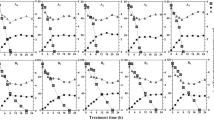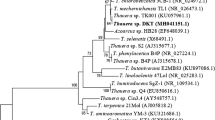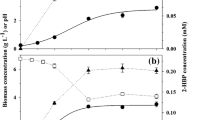Abstract
Physiological characteristics of DBT desulfurization and cell growth ofGordonia sp. CYKS1 were investigated. It exhibited a preference to ethanol in a medium containing two carbon sources, ethanol and one of the carbohydrates used, glucose, sucrose, maltose, and galactose although it consumed both carbon sources simultaneously. Cell growth on ethanol or glucose followed the Monod kinetics. The optimal range of pH for the desulfurization of DBT and the cell growth was 7 to 8. The desulfurization rate decreased about 30% at pH 6, and no significant desulfurization or cell growth was observed at pH 5. As the initial DBT concentration increased up to 1.5 mM, the desulfurization rate also increased while no significant changes in the growth rate were observed. The maximum desulfurization rate was 12.50 μmol L-1 h-1 at an initial DBT concentration of 1.5 mM. Cell growth and desulfurization activity were severely inhibited by the presence of 2-hydroxybiphenyl (2-HBP). When 0.05 mM of 2-HBP was added at the beginning, both of the desulfurization rate and cell growth rate decreased about 20%. It was found that cell growth and desulfurization were completely inhibited in the presence of 2-HBP at 0.15 mM or a higher concentration. The inhibition by 2,2′-dihydroxybiphenyl (DHBP) was less severe than 2-HBP. About 80% of desulfurization activity was retained in the presence of 2,2′-DHBP at 0.4 mM.
Similar content being viewed by others
References
Chang, J. H., Rhee, S. K., Chang, Y.K. and Chang, H.N., “Desulfurization of Diesel Oils by a Newly Isolated Dibenzothiophene-degradingNocardia sp. Strain CYKS2,”Biotech. Progr.,14, 851 (1998).
Choi, O. K., Cho, K. S., Ryu, H.W. and Chang, Y. K., “Enhancement of Phase Separation by the Addition of de-emulsifiers to Threephase (Diesel Oil/Biocatalyst/Aqueous Phase) Emulsion in Diesel Biodesulfurization,”Biotechnology Letters,25, 73 (2003).
Denis-Larose, C., Labbe, D., Bergeron, H., Jones, A. M., Greer, C.W., Al-Hawari, J., Grossman, M. J., Sankey, B. M. and Lau, P. C.K., “Conservation of Plasmid-encoded Dibenzothiophene Desulfurization Genes in Several Rhodococci,”Appl. Environ. Microbiol.,63(7), 2915 (1997).
Denome, S.A., Oldfield, C., Nash, L. J. and Young, K. D., “Characterization of the Desulfurization GenesRhodococcus sp. Strain IGTS8,”J. Bacteriol.,176, 6707 (1994).
Gallado, M. E., Fernadez, A., Lorenzo, V.D., Garcia, J. L. and Diaz, E., “Designing RecombinantPseudomonas Strains to Enhance Biodesulfurization,”J. Bacteriol.,179(22), 7156 (1997).
Gallagher, J. R., Olson, E. S. and Stanley, D. C., “Microbial Desulfurization of Dibenzothiophene: A Sulfur-specific Pathway,”FEMS Microbiol. Lett.,107, 31 (1993).
Gray, K.A., Pogrebinsky, O. S., Mrachko, G. T., Xi, L., Monticello, D. J. and Squires, C. H., “Molecular Mechanisms of Biocatalytic Desulfurization of Fossil Fuels,”Nat. Biotechnol.,14, 1705 (1996).
Inoue, J., Shaw, J. P., Rekik, K. and Harayama, S., “Overlapping Substrate Specificities of Benzaldehyde Dehydrogenase (the xylC Gene Product) and 2-Hydroxymuoic Semialdehyde Dehydrogenase (the xylC Gene Product) Encoded by TOL Plasmid pWWO ofPseudomonas putida,”J. Bacteriol.,177, 1196 (1995).
Izumi, Y., Ohshiro, T., Ogino, H., Hine, Y. and Shimao, M., “Selective Desulfurization of Dibenzothiophene byRhodococcus erythropolis D-1,”Appl. Environ. Microbiol.,60, 223 (1994).
Kayser, K. J., Bielaga-Jones, B. A., Jackowski, K., Odusan, O. and Kilbane, II J. J., “Utilization of Organosulfur Compounds by Axenic and Mixed Cultures ofRhodococcus rhodochrous IGTS8,”J. Gen. Microbiol.,139, 3123 (1993).
Konishi, J., Ishii, Y., Onaka, T., Okumura, K. and Suzuki, M., “Thermophilic Carbon-sulfur-bond-targeted Biodesulfurization,”Appl. Environ. Microbiol.,63, 3164 (1997).
Kropp, K.G., Andersson, J.T. and Fedorak, P. M., “Bacterial Transformation of 1,2,3,4-Tetrahydrodibenzothiophene and Dibenzothiophene,”Appl. Environ. Microbiol.,63(8), 3032 (1997).
Lee, M.K., Senius, H.D. and Grossman, M. J., “Sulfur-specific Microbial Desulfurization of Sterically Hindered Analogs of Dibenzothiophene,”Appl. Environ. Microbiol.,61(2), 4362 (1995).
Li, M. Z., Squires, C.H., Monticello, D. J. and Chids, J.D., “Genetic Analysis of thedsz Promoter and Associated Regulatory Regions ofRhodococcus erythropolis IGTS8,”J. Bacteriol.,178(22), 6409 (1996).
Nekodzuka, S., Nakajimakambe, T., Nomura, N., Lu, J. and Nakahara, T., “Specific Desulfurization of Dibenzothiophene byMycobacterium sp. Strain G3,”Biocata. and Biotrans.,15, 17 (1997).
Ohshiro, T., Hine, Y. and Izumi, Y., “Enzymatic Desulfurization of Dibenzothiophene by a Cell-free System ofRhodococcus erythropolis D-1,”FEMS Microbiol. Lett.,118, 341 (1994).
Ohshiro, T., Kobayashi, Y., Hine, Y. and Izumi, Y., “Involvement of Flavin Coenzyme in Dibenzothiophene Degrading Enzyme System fromRhodococcus erythropolis D-1,”Biosce. Biotech. Biochem.,59, 1349 (1995).
Ohshiro, T., Suzuke, K. and Izumi, T., “Dibenzothiophene (DBT) Degrading Enzyme Responsible for the First Step of DBT Desulfurization byRhodococcus erythropolis D-1: Purification and Characterization,”J. Fermt. Bioeng.,83, 233 (1997).
Ohshiro, T., Suzuki, K. and Izumi, Y., “Regulation of Dibenzothiophene Degrading Enzyme Activity ofRhodococcus erythropolis D-1,”J. Ferment. Bioeng.,81, 121 (1996).
Omori, T., Monna, L., Saiki, Y. and Kodama, T., “Desulfurization of Dibenzothiophene byCorynebacterium sp. Strain SY1,”Appl. Environ. Microbiol.,58, 911 (1992).
Pavel, H., Forsman, M. and Shinger, V., “An Aromatic Effector Specificity of the Transcriptional Regulator DmpR Overcomes the Growth Constraints ofPseudomonas sp. Strains CF600 on para-substitute Methylphenols,”J. Bacteriol.,176, 7550 (1994).
Piddington, C. S., Kovacevich, B. R. and Rambosek, T., “Sequence and Molecular Characterization of a DNA Region Encoding the Dibenzothiophene Desulfurization Operon ofRhodococcus sp. Strain IGTS8,”Appl. Environ. Microbiol.,61, 468 (1995).
Rhee, S.K., Chang, J. H., Chang, Y.K. and Chang, H.N., “Desulfurization of Dibenzothiophene and Diesel Oils by a Newly IsolatedGordona Strain, CYKS1,”Appl. Environ. Microbiol.,64, 2327 (1998).
Setti, L., Lanzarini, G. and Pifferi, P. G., “Immobilized Cells for Applications in Non-conventional Systems. Progress in Biotechnology 11 Immobilized Cells : Basics and Applications,” R.H. Wijffels (Ed.), Elsevier Science B. V., 777 (1996).
Setti, L., Lanzarini, G. and Pifferi, P. G., “Dibenzothiophene Biodegradation by aPseudomonas sp. in Model Solutions,”Process Biochem.,30, 721 (1995).
Wang, P. and Krawiec, S., “Kinetic Analyses of Desulfurization of Dibenzothiophene byRhodococcus etythropolis in Batch and Fed-batch Cultures,”Appl. Environ. Microbiol.,62, 1670 (1996).
Author information
Authors and Affiliations
Corresponding author
Rights and permissions
About this article
Cite this article
Kim, Y.J., Chang, J.H., Cho, KS. et al. A physiological study on growth and dibenzothiophene (DBT) desulfurization characteristics of Gordonia sp. CYKS1. Korean J. Chem. Eng. 21, 436–441 (2004). https://doi.org/10.1007/BF02705433
Received:
Accepted:
Issue Date:
DOI: https://doi.org/10.1007/BF02705433




